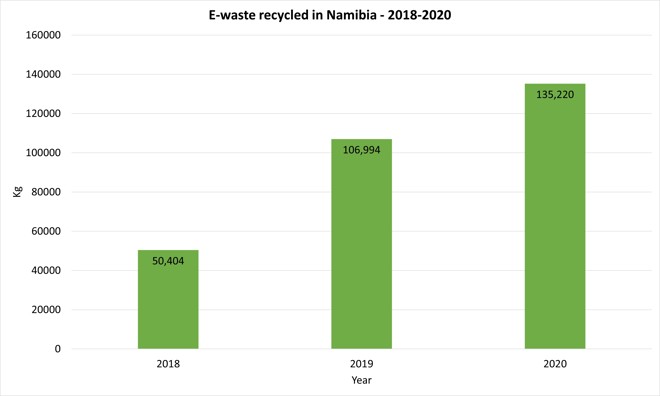Namibians continues to recycle e-waste
Press release June 8, 2021 E-waste E-waste namibia Recycling Namibia Computer recycling Waste management Eletronic waste Weee SADC South AfricaDespite 2020 being a year with COVID-19 restrictions, Namibians have recycled more e-waste than ever. NamiGreen E-waste publishes their annual e-waste statistics.

2020 was a year where many businesses had to close, seize operations, and reduce output due to the COVID-19 restrictions. In the recycling industry in Namibia, local recycling joint-venture NamiGreen, has seen an increased interest in recycling electronic waste, or e-waste, as NamiGreen received and recycled 26 % more e-waste compared to 2019.
The total amount of e-waste recycled reached 135,220 kg, or the equivalent to 13,500 desktop computers not ending up in landfills.
The CEO of NamiGreen, Mr. Per Hansen explains that "an increased awareness on recycling throughout Namibia, great service, availability, and professional handling of e-waste is attractive for our clients. Many citizens and organizations, private or public, literally have garages, rooms, hallways and even containers filled with old electronics, computers, and IT-equipment that they no longer use. Essentially the equipment is just taking up valuable floor space that could be used for better purposes. That is where NamiGreen comes in handy - we offer our clients a free collection service in Windhoek and Walvis Bay and depending on the amount of e-waste, we usually finish the job in a day or two".
Why is recycling e-waste important?
Before e-waste recycling operations started in Namibia, the practice was to chuck out old electronic gadgets and devices in the bin, which essentially means landfilling the devices. The problem is, however, that majority of all electronic gadgets and devices contain hazardous materials that can cause harm to the precious Namibian eco-systems we have around us, to human and animal health as well as pollute our drinking and fishing waters if the electronics are not recycled properly.
Mr. Hansen explains that "NamiGreen sees a growing concern for the Namibian environment amongst the citizens and organizations in Namibia. Many people and organizations congratulate us that we are doing something for the environment, and that we also 'create jobs from something that would otherwise end up as trash'".
Dampened growth in 2021
Despite 2020 being the best year in the history of e-waste recycling in Namibia, 2021 is forecasted to have a more relaxed growth. Many businesses had to close in 2020 and 2021 offers a high degree of uncertainty in terms of job creation and business startups. NamiGreen explains that they are seeing the impact of these challenges now but offers consolation that it is not the first time that Namibia has seen hard times, and yet still come out strong. Mr. Hansen, further explains an increased awareness in the Namibian society, increased governmental focus and the work of organizations like Recycle Namibia Forum all help put a focus on the e-waste problems.
For more information about e-waste recycling, please see https://www.namigreen.com
Fact box:
- NamiGreen E-waste (https://www.namigreen.com) - a joint-venture between local logistics company Transworld Cargo and Danish PEHANSEN, founded in 2018. Has roots dating back to 2013 when the initiative was started by Transworld Cargo under the name Transworld Cargo E-waste.
- E-waste or electronic waste is the fastest growing waste stream in the world according to the United Nations.
- According to the UN, 80 % of all e-waste generated annually on global scale, is not recycled.
- More than 55.6 million metric tons of e-waste was generated globally in 2019 (latest figures). In 2030, that is forecasted to reach 70 million metric tons annually according to the UN.
- The continent with the highest recycling rate is Europe, recycling 35 % of all its e-waste, Asia comes in 2nd with 22%, Americas 17 % and Oceania with 6%. Africa recycles around 0.5 % (UN)
Contacts
Mr. Per E. Hansen
Founder / MDNamiGreen
✉ info@************* Reveal...
☎ (+264************** Reveal...
https://www.namigreen.com
Subjects
E-waste E-waste namibia Recycling Namibia Computer recycling Waste management Eletronic waste Weee SADC South Africa






 Follow
Follow